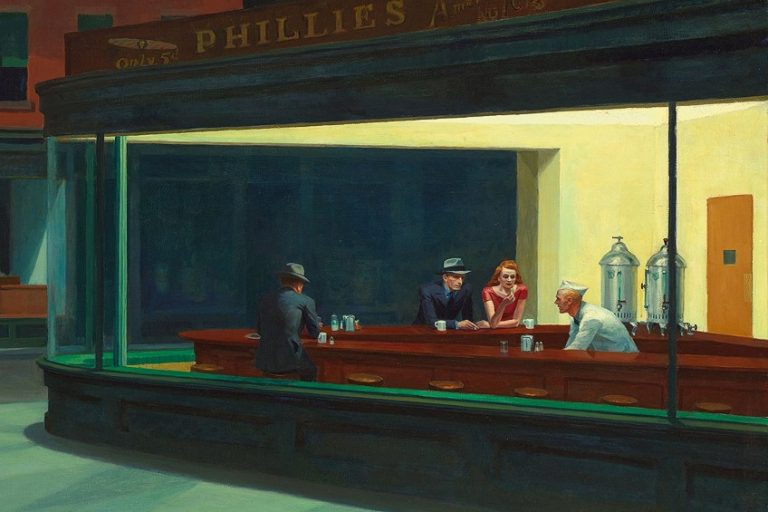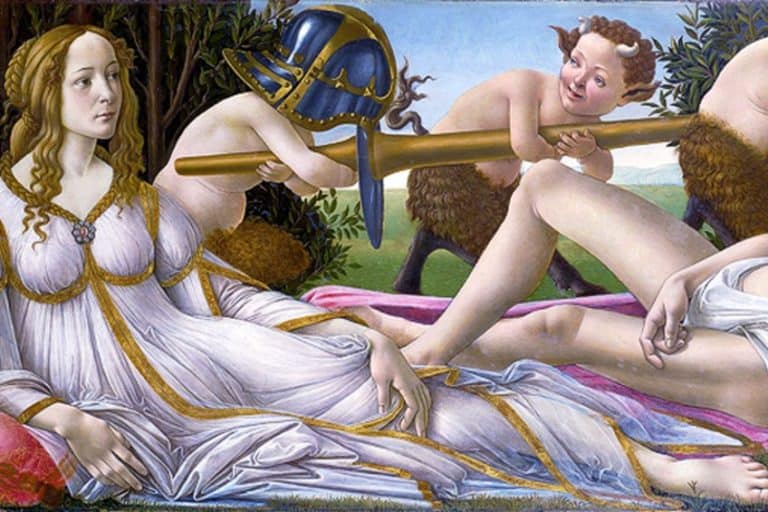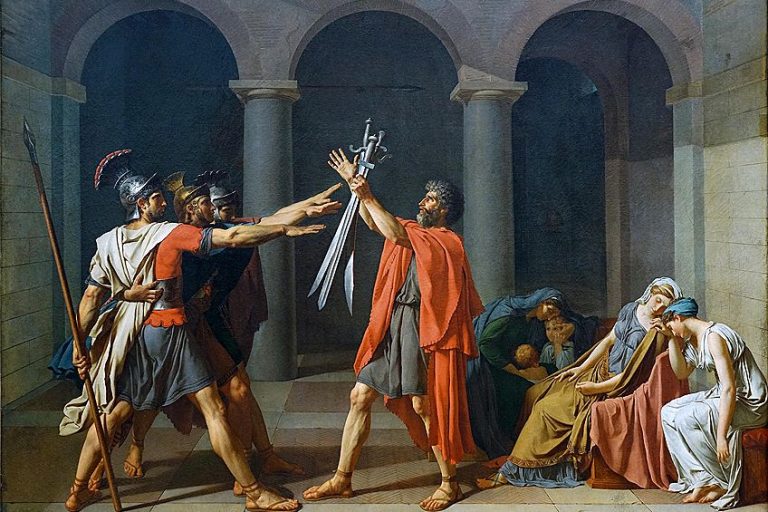“The School of Athens” Raphael – A Homage to Greek Philosophy
Have you ever wondered what it would be like to attend a special school, set in Classical times, and surrounded by fellow high thinkers, scholars, and philosophers? You might not be too keen to wear a tunic, however, we can appreciate the notion from our modern point of view. In this article, we will explore one of the most renowned paintings from the Renaissance that was created as a homage to Greek philosophy known as The School of Athens by Raphael. Keep reading for an in-depth analysis of this famous painting, including its creator, and the unique symbolism behind the artwork!
Table of Contents
Artist Abstract: Who Was Raphael?
Formally recognized as Raffaello Sanzio da Urbino, the famous High Renaissance painter Raphael was born in March, 1483 in Urbino, Italy, which was a central city. His father, who painted for Duke Federigo da Montefeltro, taught him the basic skills in painting and was also rumored to have been tutored by Pietro Perugino, a well-known painter from the Umbrian School.
Raphael also lived and worked in Florence and Rome for significant periods of his life, which significantly influenced his artistic style.
| Artist Name | Raffaello Sanzio da Urbino |
| Date of Birth | c. 1483 |
| Date of Death | 6 April 1520 |
| Nationality | Italian |
| Associated Movements, Themes, and Styles | High Renaissance, Italian Renaissance, human grandeur, portraiture, and religious art |
| Mediums | Painting, drawing, and architecture |
Raphael was most famous for his unique personal style, which was characterized by a skillful utilization of colors and compositional elegance. He was commissioned by the Pope to paint in the Vatican Palace, creating a series of frescoes that are recognized as some of his best artworks. Raphael was known to be a pleasant man and easily socialized with others.

The School of Athens by Raphael in Context
Raphael, who painted The School of Athens around the years 1509, was among the greatest High Renaissance masters, and formally recognized as one of “the big three”. The trio of High Renaissance masters included Leonardo da Vinci, Michelangelo, and Raphael, the latter of whom created this majestic painting. The School of Athens has lived on for hundreds of years and is among one of the most revered Renaissance paintings in the history of art. To introduce you to the odds and ends of this famous artwork, we will dive into a contextual anaylsis of the work and its production.
The creator of “The School of Athens”, Raphael, was considered to be a child prodigy, who since his teenage years, had shaped the course of European art history.
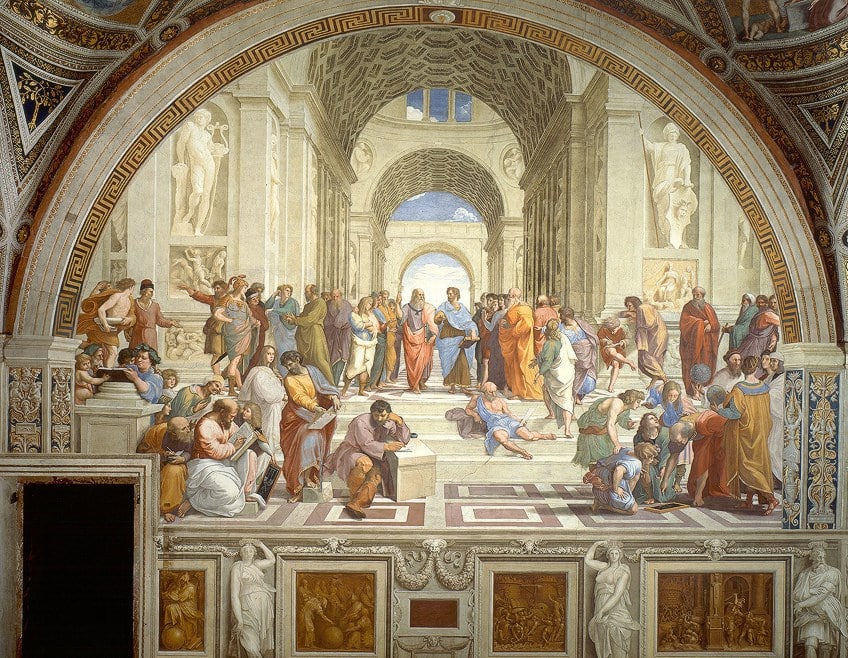
Raphael’s remarkable legacy can be understood best in his expert handling of elements such as line, color, and composition in painting, which was immortalized in The School of Athens. To help you grasp the full meaning of the work, we will examine the formal elements of The School of Athens painting by looking at the subject, Raphael’s utilization of color, line, and perspective, as well as a few intriguing points of interest.
| Date | c. 1509 – 1511 |
| Medium | Fresco painting |
| Genre | History painting |
| Dimensions (cm) | 500 x 770 |
| Series | Part of the Stanza della Segnatura series of frescoes |
| Where It Is Housed | Stanza della Segnatura, Vatican Museums, Vatican City, Italy |
Additionally, we will help you answer some of the burning questions many students have about the work, including questions such as: What is Plato’s gesture in The School of Athens, and what is meant by it? Why were the Greek god Apollo and the goddess Athena included in The School of Athens? These are just a few interesting questions we will unpack below!
A Brief Socio-Historical Overview
Raphael moved to Rome during the year 1508, which was recognized by the Italian historian and writer, Giorgio Vasari, as the third phase of the artist’s life. Raphael’s first phase was in Umbria and the second phase was most likely between 1504 and 1508.
During Raphael’s time in Umbria and Florence, his artistic styles evolved and shifted. In Umbria, he was known to have two prominent teachers, namely, Timoteo Viti and Pietro Perugino. During this period, he also received several commissions for altarpieces, including Coronation of the Virgin (1502) and The Marriage of the Virgin (1504).

Raphael was influenced by various great artistic names during his Florence years, including Leonardo da Vinci and Michelangelo, who were also known artistic “rivals”. The techniques that Da Vinci utilized included sfumato and chiaroscuro, which was subsequently adopted by Raphael, who applied the technique often in his paintings.
Raphael was known for establishing a unique style, however, he also ruffled some feathers among other artists and was accused of stealing techniques and styles from other artists.
During Raphael’s time in Florence, he painted pieces such as La belle jardinière (1507) and The Entombment (1507). The latter painting had been known to resemble that of Michelangelo’s paintings of the same subject and became a testament to how Raphael experimented with similar styles while drawing inspiration from his contemporaries.
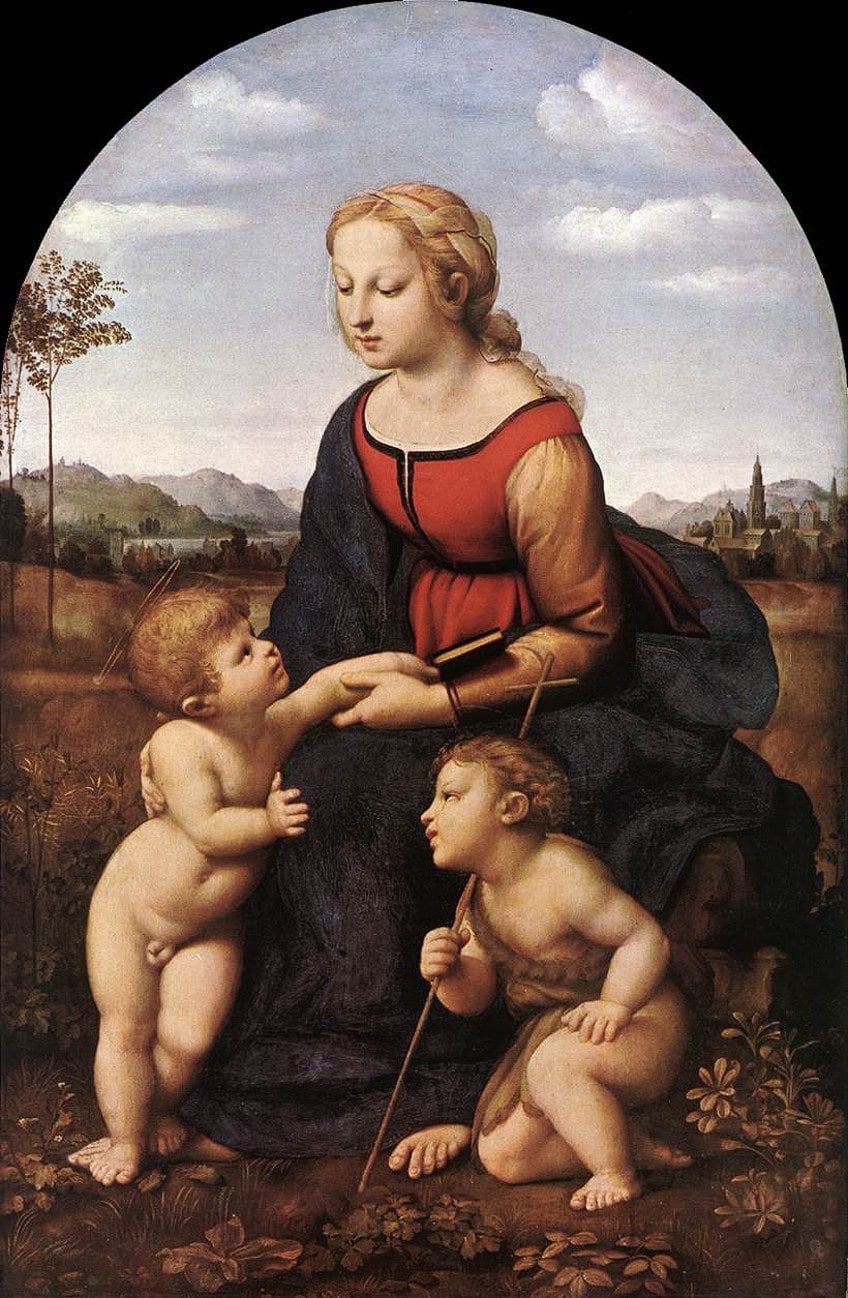
Raphael’s life in Rome began around 1508 and he was reportedly invited by Pope Julius II to paint the interior walls of the palatial suites. The artist ended up staying in Rome and painted for the successive Pope Leo X (1531-1521).
The School of Athens painting was part of the commissioned artworks by Pope Julius II, when Raphael moved to Rome. The Italian architect Donate Bramante was believed to have recommended Raphael to the Pope, as he was working on the architectural plans for the redesign of the St. Peter’s Basilica (c. 1506-1626). This was also when Michelangelo was painting the Sistine Chapel’s ceilings for the Pope.
According to reports, the Pope ordered Raphael to remove and paint over existing frescoes that were on the walls. The older frescoes were initially created by notable artists such as Pietro Perugino, Pierro della Francesca, and Luca Signorelli.
The Four Stanze and the Pope’s Library
While Michelangelo was occupied with the Sistine Chapel, Raphael got to work decorating the private suites, otherwise referred to as the “Papal apartments” of the Pope. Four rooms were set for decorations and were also known as the “Raphael Rooms” or Stanze di Raffaello. These rooms, or as they say in Italian, stanze, included Sala di Costantino (Hall of Constantine), Stanza di Eliodoro (Room of Heliodorus), Stanza dell’Incendio del Borgo (The Room of the Borgo Fire), and the Stanza della Segnatura (Room of the Segnatura).

Raphael began working on the Stanza della Segnatura, which was utilized as the Pope’s study with his library comprised of a selection of books from different disciplines. The subject of The School of Athens painting, which we will discuss below, was well-suited to the function of the room, which we will unpack below.
Raphael painted frescoes on the walls in each stanza, namely, east, west, south, north, and the entire ceiling. “The School of Athens” was painted on the east wall of the “Philosophy Room”, as it was also referred to.
It was also reported to be the third painting completed after the first two, namely, Disputation of the Sacrament, otherwise known as Disputa, (1509-1510), on the west wall. The second painting was The Parnassus (1509-1511), which was on the north wall and a lunette painting titled Cardinal and Theological Virtues (1511) on the south wall.
A Formal Analysis: Compositional Overview
As we mentioned above, the Stanza della Segnatura had a theme central to the intellectual and creative faculties of the humanities, or as it was called, “human knowledge”. These included the fields of philosophy, theology, poetry, and justice. Below, we will take a closer look at one of the most famous frescoes from these hallowed walls, The School of Athens, which was a tribute to Greek philosophy.

Analyzing the Subject of The School of Athens
In The School of Athens, Raphael presents a scene filled with sitting and standing men, who debate, contemplate, and appear posed in calculating and mentally engaged positions. The figures in the composition all represent some of the most important ancient and classical philosophers and scientists. The reference to Athens and Greece is seen in the style of the architecture, which appears to be a Classical Greek style, set in a similar design to that of the one in the St. Peter’s Basilica building that Donate Bramante, whom we mentioned earlier, redesigned.
The central figures are two of the most revered Ancient Greek philosophers, namely, Plato who is on the left and Aristotle on the right side.
In both figures’ left hands, we can see two books, namely Plato’s Timaeus and Aristotle’s Ethics. Both figures are also gesturing with their right hands. Plato is pointing upwards with his index finger and Aristotle’s hand is raised, with his palm facing down and parallel to the floor, as if he is about to lay his hand on something.
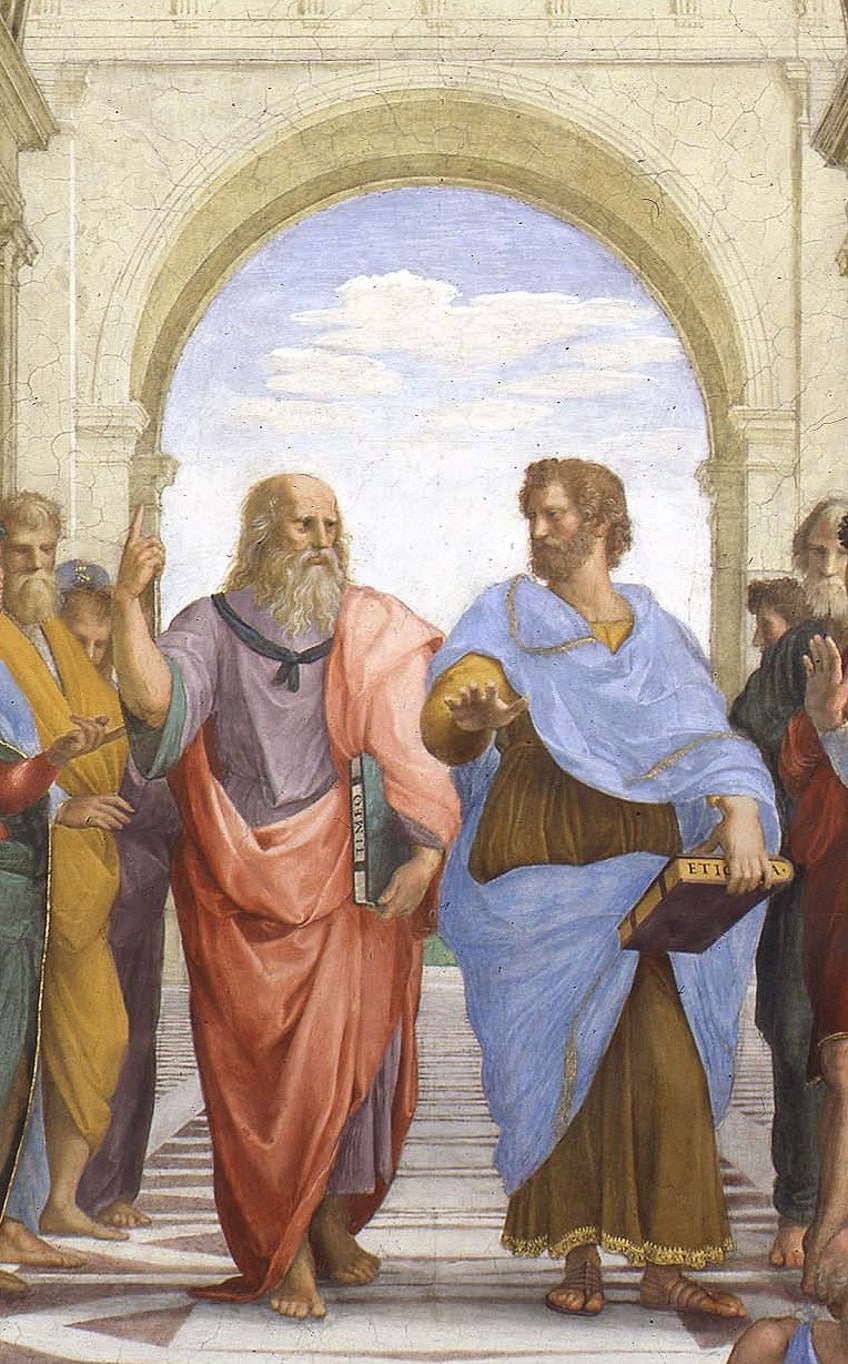
There are dozens of figures presented here around the two philosophers, with their exact identities a subject of ongoing debate. Some have been identified as ancient philosophers, scholars, and scientists but also as Raphael’s acquaintances. Starting from the far left of the composition, we see a figure that appears quite rushed, almost running into the composition. This figure appears to be looking at the figure next to him, who is gesticulating to another figure. In the bottom corner, we see a man sitting next to a child, who is looking straight at us, the viewers.
This man was possibly Zeno of Citium, who was known to be a Hellenistic philosopher.

Other prominent figures in the left half of the composition include the Greek philosopher Epicurus, the man with the green crown of leaves on his head, who appears to be writing. We also see Anaximander in the bottom left foreground, who was a pre-Socratic Greek philosopher and scientist. Next to him sits a man who was thought to be Pythagoras, accompanied by Archimedes, who was a Greek mathematician and scientist; he is holding a board with theorem written on it (some sources suggest that this could be the Greek philosopher Anaxagoras).
The elderly man sprawled out on the steps of the central plane is said to be the controversial founder of Cynic philosophy, Diogenes, who was most famous for his harsh criticism against Greek cultures of his day.
Near the middle of the foreground, Raphael depicts Heraclitus of Ephesus as sitting with his head resting on his left hand and a pen in his right hand. One can also spot a piece of paper on a slanted marble block and an ink pot behind his resting elbow, which indicates that he was in the process of writing something. Heraclitus appears in deep thought and was thought to resemble Michelangelo.

Other notable figures on the left side include Socrates, who has his back to the two central figures and is dressed in an olive green robe. His students were Plato and Xenophon. Standing directly opposite Socrates is either Alexander the Great or the Athenian general Alcibiades, who appears engaged in conversation. If we look at the right-hand side of the composition, prominent figures spotted here include Plotinus, Zoroaster, Ptolemy, Euclid, and Diogenes near the middle ground. Diogenes appears quite relaxed as he rests his elbow on a step while reading a piece of paper in his left hand. Euclid, an important figure of geometry, was illustrated to resemble the architect Bramante, who passed his knowledge of geometry to Raphael.
It is important to note that it is not clear who all the figures are in “The School of Athens” painting since some may appear to resemble more than one person.
Famous Artists in The School of Athens
Apart from portraying Michelangelo as Heraclitus, Raphael also included a self-portrait in the painting alongside portraits of other artists such as Leonardo da Vinci and Donate Bramante. Leonardo da Vinci was portrayed as Plato while Bramante was depicted as either Pythagoras or Euclid.
Raphael’s self-portrait is reportedly embodied by the figure of Apelles of Kos, who was a famous ancient Greek painter.
We can also see Raphael’s face nestled between other figures to the far right, where the arch meets the pillar. He stands, wearing a black hat, next to the figure who is holding a globe on the fingertips of his right hand. The globe appears to be a visual example of the stellar system cast with another figure also holds a globe of the earth.

Background Statues in The School of Athens
There are two statues in the background of the composition with each on opposite sides of the court area. To the far left is Apollo and to the far right is the Greek goddess Athena, who is known as Minerva in Roman mythology. Apollo is the god of many things, namely, light and the Sun, including archery, prophecy, truth, healing, dance, music, and more. Athena symbolizes justice, victory, law, wisdom, and strategic war.

Apollo stands with a lyre in his left hand and is positioned to the left side of the composition so that he could be closer to the north wall painting, Parnassus, which symbolized the field of poetry in the humanities. Similarly, Athena symbolized philosophy and wisdom, which also corresponded to the south wall painting Cardinal and Theological Virtues, depicting the field of law.
Exploring the Architecture in The School of Athens
As we mentioned earlier, the architectural setting was inspired by the St. Peter’s Basilica building, which was redesigned by Bramante. The layout also resembles the shape of a Greek cross, while the ceiling above the hall was executed in a coffered barrel vault style, which was also a style we see in Roman architecture. We also see other architectural patterns, namely a geometric band of interlocking squares, decorating the inside of the main archway in the foreground.
These are referred to as Greek Frets or Greek Key and were considered common decorative patterns in Classical Greek and Roman architecture, as well as pottery.
Color and Light in The School of Athens
The entire composition of The School of Athens depicts a light-filled space. We see this especially near the background, where the architectural space widens and provides us with a glimpse of the blue sky and white clouds. The color scheme utilized in this fresco was generally light. Raphael did not utilize dark tones and chose to use softer tones described as “muted” colors, which were evident in the men’s robes. This was an indication of how Raphael utilized the sfumato and chiaroscuro techniques.

Furthermore, the subdued color tones were characteristic of Raphael’s painting technique, which gently leads our gaze around the entire composition. Raphael utilized color in a realistic manner to portray how the light falls from the openings in the background. The two central figures are seemingly highlighted by the archway opening directly behind them. There is also an opening above the figures, which suggests another source of light that we cannot see.
Perspective in The School of Athens
There is much to be said about how Raphael depicted and utilized elements of space in The School of Athens painting. The use of linear perspective and a vanishing point relies on Rapahel’s utilization of the architectural setting. Firstly, the foreground opens, as if it is a stage that we can walk into. In other words, the composition welcomes us, the viewers, to participate in the philosophical calculations and contemplations.
This is emphasized by the large arch, which almost frames the composition and can be compared to a theater space.
The horizon line falls just along Plato and Aristotle’s head lines, which is further emphasized by the strong horizontality of the figures placed right next to each other on the same platform that the two central figures are standing on. This horizon line also falls under the bases of the two flanking statues of Apollo and Athena.
As part of linear perspective, the orthogonal lines converge from the foreground, notably the grouping of figures in the left and right corners, to form the vanishing point. The slanted marble block also adds to the perspectival lines, as they converge from below.

On the floor in the foreground, a series of squared patterns add to the spatial awareness. The vanishing point falls between the two central figures of Plato and Aristotle in the sky in the background. From above, one can notice the converging lines that form as a result of the alignment of the barrel vaulting, of which there are two archways and a third near the end of the hall, behind the central figures.
The stage-like arena also casts the viewer as a spectator into the play set by Raphael, who casts himself alongside other famous figures of his time in a play of “making history”. This act of multi-layered observation into the past and pre-determined cast of history-makers makes the work appeal to philosophical thinkers. We also notice that there is quite a large section of unfilled space in the foreground, most of the figures are either grouped to the left and right sides of the composition. Additionally, these groups are on two tiers, which consist of the four steps that run along the midsection of the hall.
This elevation of a few figures elevates the perception of multiple perspectives in the scene and provides balance in terms of how Raphael utilized linear perspective.
Interesting Facts and Symbolism in The School of Athens
While there are significant symbols and references in The School of Athens by Raphael, an important question that many ask is “what is Plato’s gesture in School of Athens, and what is meant by it?”. Plato’s right index finger appears to be pointing to the sky while Aristotle’s right hand is depicted as gesturing toward the ground. The hand gestures of both philosophers are clear examples of their respective philosophical beliefs.
Plato points to the sky to show that he believes the “real” world is the one that we are not able to see. The real world that becomes “real” to us through our senses is argued to be the “real” world by Aristotle, who gestures downwards. This subtle different in hand gestures to differentiate two different philosophies about the real world showcase Raphael’s objectivity and respect for both historical figures and schools of thought.
Some of the key differences and characteristics of Plato and Aristotle’s philosophies include Plato’s ideas as more abstract and theoretical, and Aristotle’s ideas, as more practical.

The philosopher’s theories on form were based on their individual and differing ideas. For example, Plato believed that form was experienced in the mind, through ideas, while Aristotle believed that form was part of physicality and not “independent” of them, as per Plato’s belief. Consistent with the theme of philosophy, as we discussed above, The School of Athens painting depicts references to theoretical ideas and ideas based on physicality.
The inclusion of the sky and its ephemeral texture in contrast to the rigid architecture of the building possibly indicates the two opposing schools of thought that present the ideas of reality and our perception of reality as caught between the physical and intangible planes of existence.
A Stanza with a View
In The School of Athens analysis above, we looked at various contextual and formal elements that make this fresco painting so profound in its symbolism and technical execution. It has been a High Renaissance masterpiece and since its creation in the 1500s and has received wide acclaim. In fact, numerous records and art historians detail the praise and success it had since its release.
The School of Athens painting has been reproduced numerous times and worth mentioning is Raphael’s famous preparatory drawing of the composition, which was displayed at the Biblioteca Ambrosiana located in Milan. Furthermore, we will find a likeness of Raphael’s Renaissance version to the mosaic from Pompei titled Plato’s Academy mosaic (100 BCE-79 CE).
Raphael created masterpieces such as “The School of Athens” during a period when he competed with other master artists. He was undoubtedly influenced and inspired by not only Michelangelo’s style but also the techniques of Leonardo da Vinci. Raphael’s painting holds a complexity of meaning and rich history that makes it one of the best examples of High Renaissance art and gives the Stanza della Segnatura a view worth contemplating.
Take a look at our The School of Athens webstory here!
Frequently Asked Questions
Who Painted The School of Athens?
The School of Athens (1509-1511) is a famous fresco painted by the High Renaissance artist known as Raffaello Sanzio da Urbino. This celebrated Italian painter was professionally known as Raphael and was credited with creating some of the most elegant artworks of the 16th century.
Where Is The School of Athens Housed?
The School of Athens (1509-1511) by Raphael is housed in the Apostolic Palace in the Vatican City in Rome, Italy. It is painted in one of the four Raphael rooms called the Stanza della Segnatura, which used to be the Pope’s study and library.
What Does The School of Athens Painting Symbolize?
The School of Athens (1509-1511) painting symbolizes the field of Greek philosophy, one of the disciplines of the humanities or areas of human knowledge, which the main room it is painted in, the Stanza della Segnatura, aimed to represent. In The School of Athens, we see a variety of ancient philosophers and scholars debating, contemplating, and calculating. The two central figures embody the two most important ancient Greek philosophers, Plato and Aristotle.
What Is Plato’s Gesture in The School of Athens?
In The School of Athens (1509-1511), Plato’s right index finger points to the sky. This was indicative of his philosophical beliefs, which focus on abstract ideas around reality as it exists in the “realm” of the spiritual world. This was compared to Aristotle’s gesture beside him, which gestures to the earth below and was indicative of his ideas on reality as it manifested in the physical plane of existence. Plato’s hand gesture could be referring to his philosophy called the Theory of Form.
Why Were the Greek God Apollo and the Goddess Athena Included in The School of Athens?
The Greek god Apollo and the goddess Athena represent aspects that relate to the overall theme of the room that The School of Athens (1509-1511) painting is located in. The room, called the Stanza della Segnatura, was originally a study with the Pope’s library. Apollo is the God of dance, music, archery, prophecy, and truth, while Athena is the goddess of wisdom and war, which complemented the disciplines of the humanities.
Alicia du Plessis is a multidisciplinary writer. She completed her Bachelor of Arts degree, majoring in Art History and Classical Civilization, as well as two Honors, namely, in Art History and Education and Development, at the University of KwaZulu-Natal, South Africa. For her main Honors project in Art History, she explored perceptions of the San Bushmen’s identity and the concept of the “Other”. She has also looked at the use of photography in art and how it has been used to portray people’s lives.
Alicia’s other areas of interest in Art History include the process of writing about Art History and how to analyze paintings. Some of her favorite art movements include Impressionism and German Expressionism. She is yet to complete her Masters in Art History (she would like to do this abroad in Europe) having given it some time to first develop more professional experience with the interest to one day lecture it too.
Alicia has been working for artincontext.com since 2021 as an author and art history expert. She has specialized in painting analysis and is covering most of our painting analysis.
Learn more about Alicia du Plessis and the Art in Context Team.
Cite this Article
Alicia, du Plessis, ““The School of Athens” Raphael – A Homage to Greek Philosophy.” Art in Context. October 27, 2021. URL: https://artincontext.org/the-school-of-athens-raphael/
du Plessis, A. (2021, 27 October). “The School of Athens” Raphael – A Homage to Greek Philosophy. Art in Context. https://artincontext.org/the-school-of-athens-raphael/
du Plessis, Alicia. ““The School of Athens” Raphael – A Homage to Greek Philosophy.” Art in Context, October 27, 2021. https://artincontext.org/the-school-of-athens-raphael/.






